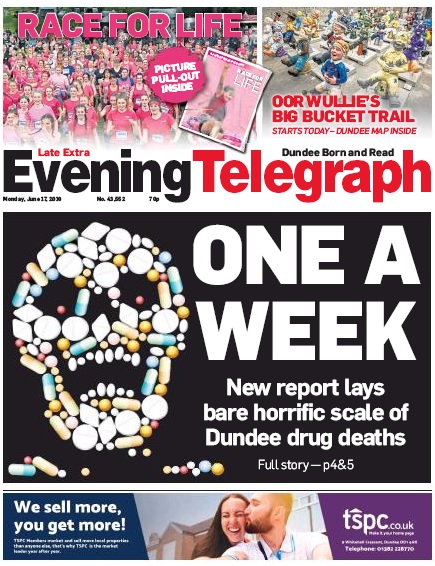A regional daily’s photograph of a man slumped on a bench was published in the public interest, the press watchdog has ruled.
The Independent Press Standards Organisation has found in favour of the Dundee Evening Telegraph after it received a complaint from Ian Macdonald, the man pictured in the photograph.
An Evening Telegraph reporter had found Mr Macdonald on the bench in an unresponsive state and, after being unable to rouse him and calling an ambulance, photographed him because he suspected he was under the influence of alcohol or drugs.
Mr Macdonald’s mother, who represented him in his complaint to IPSO, said both she and her son recognised that Dundee had issues with alcohol and drug abuse, but did not believe publication of this unpixelated photo was necessary to highlight these problems.

The Evening Telegraph has run an ongoing campaign highlighting alcohol and drug abuse
But IPSO backed the Evening Telegraph’s public interest claim after the newspaper argued the picture illustrated the extent of significant ongoing anti-social behaviour in Dundee – an issue about which it had run a series of stories.
The picture in question and the story which it accompanied have since been taken down from the Telegraph’s website, although the image can still be found on Google searches.
The story, headlined ‘Ambulance called for ‘slumped’ man in Dundee city centre’, reported that an unnamed man had been found unresponsive in Dundee city centre.
The report stated that it was believed that the man had been drinking heavily and that onlookers had called an ambulance – with one eyewitness being quoted as saying it was not the first time he had seen something like this in Dundee, and that he suspected the man had been under the influence of alcohol or drugs.
Complaining to IPSO under Clause 2 (Privacy) of the Editors’ Code of Practice, Mr Macdonald believed the photo had intruded into his privacy and said that family and friends had identified him from the article, which caused them much distress.
His mother added that her son had longstanding personal problems, and there was no justification in publishing this image.
Denying any breach of Code, the Evening Telegraph said the photo was taken in the middle of the day in a public place where Mr Macdonald had a very limited expectation of privacy, further arguing he was not easily identifiable because his face was largely obscured.
Its reporter and called an ambulance after failing to rouse Mr Macdonald and checked his condition with police the next day after he had been to hospital.
The police confirmed he had been released without requiring any hospital treatment and was “fine”, and therefore nothing private about him was revealed by the photo because he was not experiencing a medical emergency or was in a vulnerable state.
There had been a discussion at senior editorial level about whether there was a public interest in publishing the image, and it was decided that there was due to the issues it highlighted in relation to protecting public health and safety.
The Evening Telegraph said that it was only after it had satisfied all of these steps that the decision to publish the photo was taken, but added it had removed the image immediately from its website after being contacted directly by Mr Macdonald’s mother – additionally offering her the opportunity to speak about her experience as part of its work to highlight social problems in Dundee.
IPSO found Mr Macdonald did not have a reasonable expectation of privacy in the circumstances and that the photo had not revealed any private information.
The watchdog also acknowledged anti-social activity was a topic of ongoing concern in the local community and public services, and the article and photograph had been published as part of a campaign by the publication to highlight these issues.
The complaint was not upheld, and the full adjudication can be read here.





 Follow HTFP on Twitter
Follow HTFP on Twitter